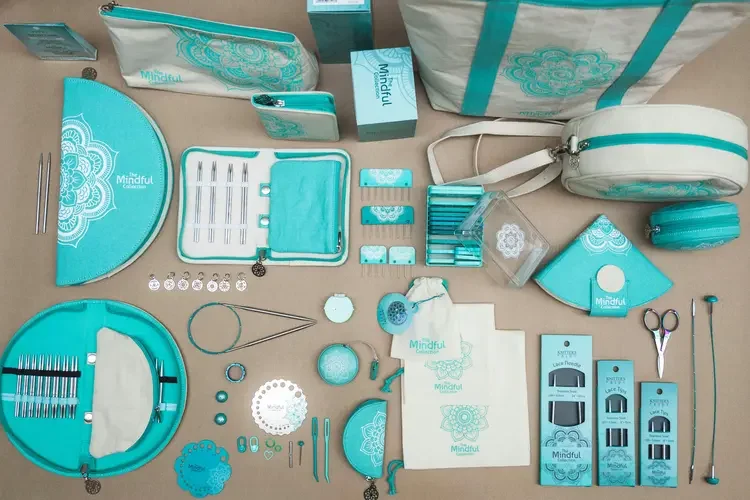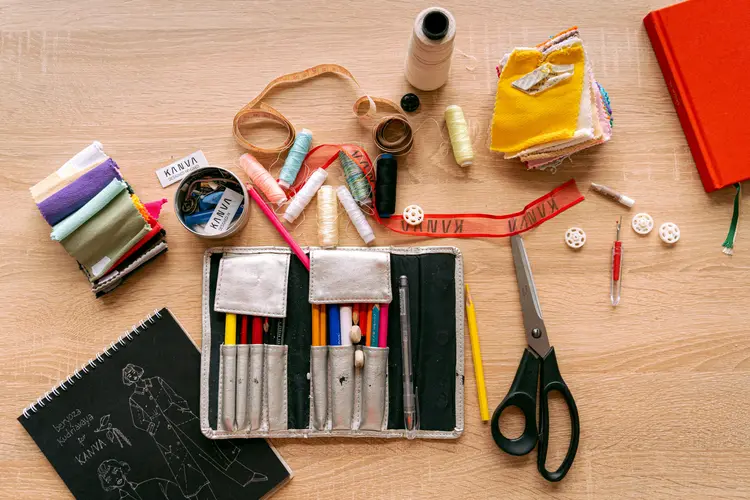Think back to those youthful days when lively play often resulted in torn clothes, promptly restored to perfection by the capable hands of our mothers. They always seemed to possess the precise tools needed for the task at hand.
As adults, it’s wise to keep a collection of essential sewing repair tools for everything from minor touch-ups to larger projects. Much like we maintain a basic toolbox complete with hammers, screwdrivers, and wrenches for household fixes, having a basic sewing kits readily available is equally indispensable.
Reasons to Invest in Sewing Kits
If you’re new to sewing or looking to improve your skills, getting a sewing kit is a wise move. These kits not only come with all the necessary tools and materials but also offer instructions to help you use them effectively. Since there are many types of sewing kits out there, it’s important to pick one that suits your needs.
For example, if you’re looking to create small clothing embellishments or spruce up your home decor, a basic sewing kits sufficient. However, if you’re planning to tackle larger projects like mending jeans or bed sheets, you’ll need a more comprehensive kit. Ultimately, a quality sewing kit contains all the essentials to kickstart your sewing journey and should be tailored to meet your specific needs.
Some Benefits of Sewing Kits
- Sewing kits offer a fantastic opportunity to enhance your skills and craft something beautiful from the ground up.
- Sewing kits are versatile tools that can be utilized for a myriad of projects, including clothing repairs, alterations, and crafting entirely new garments.
- Sewing kits typically include all the essential tools required to begin sewing, such as needles, fabric pieces, spools of thread, and additional accessories.
- Moreover, if you’re contemplating starting your own business, a well-stocked sewing kit can prove invaluable. It equips you with the essential resources needed to guarantee that your products exhibit superior quality and durability, ultimately enhancing their overall appearance and longevity.
- Some sewing kits contain all the fundamental necessities like needles and thread, while others offer extra features such as zippers and interfacing materials. It’s wise to spend a little more to access these additional components as they can greatly streamline your sewing endeavors.
- If an issue arises with your clothing, like torn seams or lost buttons, you can usually tackle it without much trouble. All you need are some sewing fabric, a needle and thread, and basic DIY skills.
Basic Sewing kits

- Hand Sewing Needles: Needles constitute one of the broadest categories of sewing tools, and they’re both compact and budget-friendly. Kits frequently provide assortments of needles in different sizes, saving you the hassle of purchasing them separately for various projects. These are usually labeled as universal or sharps needles, denoting their versatility for all-purpose sewing.
- Machine Needles: If you’re gearing up to use a sewing machine, start with Universal needles for a variety of woven fabrics. When sewing knits, switch to stretch needles. Ensure the needles size align with your fabric’s thickness. Machine needles are typically sold in packs with assorted sizes, sparing you from purchasing full packs of different sizes.
- Safety Pins:When organizing your sewing kit, it’s beneficial to include a small assortment of safety pins in various sizes. These pins are commonly employed for tasks like threading elastic through casings and turning fabric tubes right side out. Moreover, they prove handy for securing thick or multiple layers of fabric when working with materials such as tulle or quilts.
- Thimble: While not indispensable, a thimble can offer protection for your fingers during hand sewing tasks. They’re frequently included in beginner sewing kits. If you plan to undertake any embroidery work, having a thimble is highly recommended.
- Pins: Pins are essential in any sewing kits as they keep your seams in place. Plastic ball-headed pins are budget-friendly and come in assorted colors. If you’re willing to spend a bit more, consider glass head pins as they won’t melt if accidentally touched by the iron. While specialty pins may be required for sewing fine silks or delicate knit fabrics, one type of pin generally serves most purposes.
- Pincushion: You’ll need a reliable spot to keep your pins, and a pincushion is indispensable among your sewing tools. Having an empty pincushion handy next to your machine is advantageous, enabling you to swiftly remove and store pins while sewing. The white pincushion shown has a magnetic base, ensuring your pins stay secure. Magnetic pincushions are especially handy for swiftly retrieving dropped pins from the floor.
- Sewing Thread: When organizing your sewing tools on a budget, make it a priority to invest in top-quality thread brands like Rasant, Gutermann, Mettler, or Coats and Clark. Cheaper threads tend to become fluffy and break easily, causing frustration over time. Threads included in sewing kits often lack quality. Start by acquiring basic colors for your kit, such as white, cream, black, blue, red, and pink. Then, gradually add other specialty colors as needed.
- Scissors: In your basic sewing toolkit, you’ll want a large pair of dressmaking scissors and a smaller set of sharp embroidery scissors or thread snippers. It’s smart to also pick up a less expensive pair of scissors specifically for cutting paper patterns to avoid dulling your good dressmaking shears. Remember, fabric scissors should never be used for anything other than fabric. While pinking shears might cost a bit more, they can be a handy choice for seam finishing if you don’t have a serger (overlocker). However, if you do have a serger, you might want to pass on pinking shears since they might not see much use despite their decorative appeal.
- Rotary Cutter: A rotary cutter, akin to a pizza cutter in appearance, serves mainly in quilting to ensure precise straight cuts. If quilting is your focus, consider including a rotary cutter, extra blades, and a cutting mat in your sewing tools and equipment lineup. However, for those concentrating on garment sewing, this tool might not be immediately necessary.
- Seam Ripper: Hopefully, you won’t need it too often, but in sewing, mistakes are inevitable. Even seasoned sewers make errors, so don’t be disheartened if you find yourself using your seam ripper frequently, especially when you’re just starting out.
- Ruler: Obtain a standard clear ruler, preferably with markings in both inches and centimeters. While there are many advanced quilting rulers available, beginners can manage with something simple. Clear rulers offer visibility of the fabric underneath, assisting in precise measurements and cuts.
- Measuring Tape: A tape measure crafted for sewing is vital for accurately gauging body measurements. Look for one with both inches and centimeters, especially beneficial when using patterns from different regions. Steer clear of thin or plastic tape measures for sewing, as they can stretch during measurements, resulting in inaccuracies.
- Seam Gauges: A seam gauge is a handy little tool designed for measuring small hems, seam allowances, and markings. As you begin your sewing journey, having a seam gauge at hand greatly simplifies the process of measuring small increments and hems.
- Marking Sewing kits: You’ll need a way to transfer markings onto your fabric. Tailor’s chalk pencils are usually the most budget-friendly option, coming in packs with different colors like white, blue, and pink. Different colors of chalk are essential for marking different fabric shades. Chalk pencils are easy to use and brush off easily. Disappearing pens cost a bit more but accurately transfer markings. However, in hot climates, these pens tend to fade faster.
- Iron Machine: In sewing, having a steam iron and an ironing board is crucial. Most likely, you already have these items at home, so there’s no need for an extra expense. A spray water bottle can be useful for dealing with stubborn creases. Although not necessary, a tailor’s ham proves handy for pressing more intricate seam details.
- Machine Feet: Most sewing machines come with a selection of presser feet, so you usually don’t need to spend a lot on these sewing tools. However, if you’re eager to try new techniques, you might consider browsing aftermarket feet kits on platforms like Amazon or eBay. These kits are budget-friendly and offer various specialty feet, opening up a range of sewing possibilities.
- Extra Bobbins: These are a must-have! While your sewing machine usually includes a few bobbins, having extras can make your sewing tasks much smoother. It’s easy to run out of bobbins during projects, so having some pre-wound with different colors can be a real time-saver. I’d recommend getting at least 10 extra bobbins to add to your sewing tools. They’re inexpensive, but make sure they’re compatible with your sewing machine’s brand.
You may also like:
- The History Of Sewing Machine
- Using a Seam Ripper: A Step-by-Step Guide
- Different Types of Sewing Machines
- Guide To Sewing Machine Needles Size, Types, And Uses
- Sewing Machine Parts And Functions
- Count of Yarn: Explanation and Varieties
- Yarn Manufacturing Process
- Varieties of Woven Fabrics and Their Applications
- Non Woven Geotextile Fabric
- What is Sisal Fiber? Properties, Structure, and How It Made?
Share this Article!

